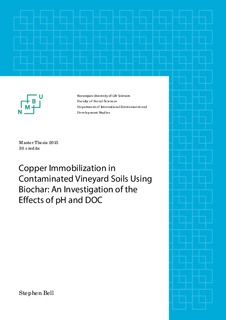| dc.description.abstract | Decades of copper-based fungicide application to vineyard soils has resulted in elevated soil-Cu concentrations observed in wine producing regions globally. While grapevines, and the wine itself, do not inherit abnormal levels of Cu, ecotoxicological concerns regarding soil microbiology, vegetation cover, and watershed contamination still remain. Biochar has been shown to have a high sorption capacity for cations, such as Cu2+, and is therefore a potential soil amendment worth investigating. The purpose of this study is to determine the effect of biochar amendment on Cu mobility in contaminated vineyard soils at varying levels of pH and DOC content. The literature is inconclusive, and generally lacking, as to the effectiveness of wood-derived biochar on Cu immobilization, especially at lower amendment rates. It is hypothesized that the liming effect of biochar and the high amount of binding sites it contributes to a soil will result in increased Cu immobilization. Additionally, immobilization is expected to be positively correlated to pH and negatively correlated to DOC concentration in soil solution. Three Cu-contaminated Austrian vineyard soils were amended with 3% (w/w) biochar (woodchips, 480˚C) and compared physically and chemically to non-amended samples. Laboratory batch sorption and desorption experiments were conducted and supernatant Cu concentrations were measured using atomic absorption spectroscopy. For all samples, biochar increased soil pH, moisture content, and surface area while it decreased readily soluble Cu. Copper sorption kinetics of all amended and non-amended soils followed a characteristic two stage process of rapid initial sorption, comprising the majority of sorption capacity, followed by a stage of gradually increasing sorption until equilibrium was reached. Copper sorption was best defined by the Freundlich isotherm model. Biochar had a positive influence on Cu immobilization in the most acidic of the three soils (pH 5.8), which can be attributed to the liming effect. Sorption capacities of all samples were brought to comparable levels when reaction pH was controlled. The positive effect of biochar amendment on Cu immobilization was no longer apparent at the pH range investigated once the liming effect was nullified. DOC batch sorption experiment results indicated a positive correlation of DOC and Cu immobilization, which could be a result of humic acid adsorption to soil surfaces. The desorption capacities of biochar amended and non-amended soils were almost identical and very minimal, indicating no negative effect of biochar addition. Before complete endorsement can be made for this type of biochar for use in field trials and later vineyard remediation, further research is recommended involving lower reaction pH, more elaborate DOC experiments, and additional subsequent desorption steps. | nb_NO |

